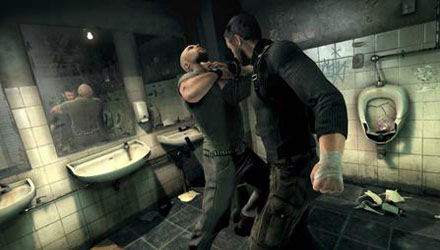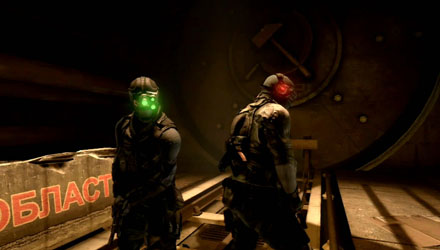Reviews
Review: Splinter Cell: Conviction
April 22, 2010, Author: Brian Gourlay
It’s a good thing that an inherent quality of stealth-action fans is patience, since Ubisoft have certainly taken their sweet time with the release of Splinter Cell: Conviction. From its original conception it was clear that a massive overhaul was in planning, with early pre-release material show a dishevelled and almost homeless looking Sam Fisher swapping shadows and gadgets for crowd mechanics and environmental combat. As the release date got closer however it became apparent that this new looks Splinter Cell was too similar to the Assassin’s Creed series and the concept of Conviction was brought back to something more similar to the original games, but with a less clinical but grittier, action-oriented tone.
This more familiar Splinter Cell is what hit the shelves last week, although it still has gone through a not-insignificant transition since the conclusion of Double Agent. The indecision that dogged Conviction’s development was a cause of concern for me as I felt it could result in the finished product suffering from a bit of an identity crisis. When making these kind of transitions there’s always a risk that the content becomes diluted, so just how does the new Sam Fisher handle? Does Conviction breathe new life into the series or are we left with a “worst of both worlds” dilemma?
Angry Sam
For as long as I can remember Splinter Cell titles, as well as the Tom Clancy franchise as a whole, have struggled to really engage the player in the game’s plot. Disembodied radio chatter directing you towards a series of interchangeable MacGuffins have been the staple of the series ever since Sam first donned his iconic night vision goggles, which this time have been symbolically removed from Sam’s arsenal. It’s good to see therefore that Ubisoft have made a real effort to address this issue and provide a more personal story and fleshed out relationships between characters.
Set around three years after the conclusion of Double Agent, Sam is now officially a civilian and has a single focus in life;to find the men responsible for his daughter’s death and bring them to justice. We’re not talking prison sentence or group therapy justice here either, Sam has nothing but revenge on his mind and this angrier mindset is well represented in the ruthless and lethal way that he deals with enemies. After playing through so many games listening to Sam walk the tightrope between loyalty to his country and his own moral compass, I enjoyed being able to experience him just let go for once.
Sam’s personal motivations go hand in hand with the motivations of his shady employer who wants to stop an impending electromagnetic attack. It quickly becomes apparent that Sam is in way over his head as Third Echelon appear to be masterminding the attack, leading to a juicy conspiracy in which it becomes harder and harder to know who to trust. This thread of the plot bucks the trend of other Ubisoft games by actually being quite interesting. Doubles and triple crosses are almost as common as snapped necks in Sam’s world this time around, and the way that the plot-line constantly switches time-lines (including the occasional foray a few days into the future) provides an effective vehicle for fleshing out back-stories and introducing the occasional plot twist.
Sneaky Snacky Snoo…
From the outset it’s clear that we’re dealing with a new Sam Fisher in Splinter Cell: Conviction; he appears to have taken a few night classes with Jason Bourne while absent from Third Echelon. There’s considerably less emphasis on patient, calculated stealth with the focus now shifting towards improvisation and a more action oriented approach. To that effect Sam’s skills have gone through a more noticeable expansion and redefinition than in any other transition between games.
The most significant of these changes is the Mark and Execute mechanic, which allows Sam to predetermine which targets he’s going to aim at before quickly killing them all at the press of a single button. It’s an interesting idea that allows for intricate planning to be accomplished relatively easily, quickly and if I say so myself stylishly, but there is an inherent flaw in the mechanic. In certain cases it allows you to perform actions that would otherwise require superhuman reactions or an unprecedented dose of luck, such as kicking in a door and instantly clearing the room with a few quick shots. These quick, merciless kills fit in perfectly with the new direction that the series has been taken in and looks absolutely fantastic to boot.
Despite allowing for some visually spectacular kills, I do feel that it can be just as detrimental to the experience in equal measure. There are restrictions in place such as putting a cap on the number of targets who can be marked but a Mark and Execute sequence amounts to a flurry of unstoppable headshots; free kills essentially. Even on the Realistic difficulty setting I feel like it’s too easy to fill your “Marks” with a takedown move and the result is that seemingly insurmountable odds can be cheaply turned around with no real effort on the part of the player.

"You've broken the splash zone rule for the last time"
That’s not to say that Sam has completely ignored his roots altogether however and there are opportunities throughout the game to get up close and personal with your target. Sam can quickly snap from cover to cover using context sensitive commands that will usually get you to your intended destination although sometimes leaves you crouching like a moron in the most illuminated position in the entire game. Talking of illumination it looks like Spinter Cell truly has cast aside its humble beginnings as lighting has been pretty drastically streamlined to a simple “Completely invisible/Lit up like a Christmas Tree” binary decision, which is something that I felt didn’t need to be streamlined.
It’s when you get close enough to smell your target’s breath that I found Splinter Cell to be at its best. Pressing the melee button will simply initiate a very slick lethal takedown; I particularly enjoyed watching Sam fire a couple of shots into the poor soul on the receiving end of the move even though it’s supposed to be a melee attack. Using the enemy as a human shield will often yield more satisfying results however, not only because it fits in well with a well timed Mark and Execute but opens up plethora of opportunities as you decide how you want to finish him off. Most of the environment can be used as a finishing move and even though the differences as merely cosmetic I still found it interesting finding as many as I could. There are several extended sequences that involve Sam performing impromptu interrogations which implement this in a much more polished way but I still found it to be more satisfying in the heat of battle.
Sam’s ability to quickly switch position as well as his renowned acrobatics served me well during Splinter Cell: Conviction as the enemy AI is actually pretty damn good and required me to constantly stay on my toes. They don’t seem to follow a particular path and will often flat out refuse to budge if they feel that holding position will slash their odds of ending up dead, and this unpredictability on their part is one the biggest contributing factor in providing a challenge for players who want to focus entirely on stealth.
Once you’ve had the misfortune of being spotted the option of charging into the fray guns blazing is available, but will more than likely result in a quick and undignified death. Splinter Cell: Conviction is not a shooter, which is why a lengthy sequence in Iraq which involves absolutely zero stealth is a real drag. The better decision would be to get out of sight again, which upon doing a silhouette of Sam will be superimposed on the screen indicating where the enemy thinks you are. It’s an interesting idea that allows players to use being uncovered as a potential tactical advantage, although it also acts as the enemy AIs Achilles heel. Enemies will often blindly fire at Sam’s silhouette and unless you whistle and yell “I’m actually over here now fellas” they tend to continue to do so for so long that you essentially have free reign to get in a perfect killing position.
The main outcome that these redevelopments achieves is that the action in Splinter Cell: Conviction is much quicker, more visceral and violent, but also a bit messy at the same time. There doesn’t seem to be any real punishment for being uncovered and in fact a lot of the conflicts in the game demand that Sam gives his trigger finger an itch. As a result the body count probably dwarves that of the four predecessors by the end, which is no mean feat considering the campaign of Conviction is surprisingly brief.
Graphical prowess? It’s pretty black & white…
In a rare departure from my usual opinion on Ubisoft games, I found the presentation of Splinter Cell: Conviction to be an unceasing source of annoyance. As is the norm with titles that fall under the Tom Clancy umbrella the production values are off the scale. You really could spend hours simply looking at how well put together and animated Sam Fisher and his adversaries are, if Ubisoft hadn’t made the insane decision to apply a lifeless monochrome filter to lengthy sections of the gameplay.
Whenever Sam sneaks into the shadows, the colour is flushed out of the game world to indicate that he is invisible to the enemy. Obviously if everything goes according to plan this is going to be the case for the majority of each section which results in a lot of the levels just looking plain dull. Other than environmental points of interest and enemies retaining their original hue no stylisation is applied to the game when you go out of sight; the entire screen really does just melt away into a collage of slightly different grays. It just seems bizarre that Ubisoft couldn’t think of a less intrusive approach to the stealth indicator, especially considering the other significant visual addition to Splinter Cell: Conviction displays evidence of some real creativity from the Montreal studio.
It’s a feature that’s become a staple of the pre-release hype for Conviction but the way that objectives, hints and story elements are projected directly onto the environment is an interesting concept that is executed very well in most cases. The way that current objectives and short videos relevant to the current situation are presented gives the impression that you have a direct feed into Sam Fisher’s mind. Every time something pops into his head it’s broadcast onto the nearest surface for you to interpret. When it comes to the more mundane usages such as displaying context sensitive actions it’s not quite as effective but it still certainly raises some questions about the future viability of the tried and tested HUD functionality.
Sounds Fisher…
Despite Ubisoft somehow managing to do the opposite of polishing a turd (pooing on a gem?) with the visual style of Conviction no such mistakes have been made with the audio. The new direction allows for more up close and personal interaction with the voice acting maintaining consistently high standards. Michael Ironside does grumpy and cynical very well and it fits in with Sam’s attitude in this instalment while the other major characters are equally well represented. Even the stock NPCs usually provide some interesting conversations to eavesdrop on, although they tend to revert to an endless loop of catchphrases once they’ve realised Sam is in the room. Conviction is the first Splinter Cell in which I found myself making an effort to listen to what people had to say rather than just treating it as background noise. Although this is more down to the narrative being to a higher standard in general it’s good to see that the production values have been maintained.
Sound effects and general ambient noise are also a highlight, although that’s hardly surprising considering how the sound of a pair of night vision goggles powering up is a long standing trademark of the series if not the stealth genre as a whole. These effects take a back seat this time however as more effort appears to have been put into accompanying Sam’s hand to hand combat with bone crunching punctuations. These visceral snaps, whips and thuds go a long way to emphasising Sam’s image as a hasty but brutally effective combatant. I found the firearms to feel a bit underpowered even without a suppressor however. Anything other than a clean headshot will result in your target shrugging off the hit with Terminator-esque disregard, which is compounded by most of the weapons giving off a bit of a muffled whimper instead of the air splitting bang that I felt they should have.
Spy vs Spy
Double Agent set a difficult precedent to follow with its multiplayer element in that it offered something very different to the single player campaign as well as being bloody brilliant in its own right. Splinter Cell: Conviction’s multiplayer is quite simply brilliant however, and exponentially increases the lifespan of the game as a whole. The co-op story focuses on the characters of Archer and Kestrel, an American/Russian tag team in what is essentially a prequel to Sam’s campaign. The story itself is unfortunately a bit more in line with previous game but the ability to work together through a completely separate campaign is provides more enjoyment than anything the single player campaign brings to the table. The Last Known Position feature in particular sets up some up some nice diversionary tactics and the difficulty is ramped up enough simply by throwing more enemies into each of the maps. My only complaint is that explicit co-op moves are pretty much restricted to opening doors so don’t expect any Army of Two style back to back moves, but it’s a testament to the strength of Splinter Cell: Conviction’s core gameplay that the co-op still works very well without having to be chopped and changed.

Like Army of Two without the sexual tension...actually that's in there too
The co-op modes are excellent and are probably enough of a reason to buy Splinter Cell: Conviction on their merit alone, however I found the Face-Off mode to cast them to the sidelines with relative ease. This adversarial game mode sees Archer and Kestrel turning on each other and competing to kill as many AI controlled enemies as possible, with extra credit being awarded for taking each other down. It’s such a simple idea but provides so many moments of brilliance that I was begging for more at the end of each round. The thrill of getting the drop of a group of terrorists could instantly be tempered as they started dying by someone else’s hand, someone who is probably training their gun on you right now…
Without Splinter Cell: Conviction’s multiplayer I would imagine that most fans would feel pretty short changed by the whole experience due to the alarmingly short playtime of the campaign. As it stands, it really does pull Conviction over the threshold between being a good game and being a game that you can return to over and over. The co-op story essentially acts as a game in its own right while the other game modes and customisation options greatly increase the game’s longevity. Although it was Sam Fisher that initially turned my head, it was Archer and Kestrel who kept pulling me back in.
Convinced of Convicted?
Playing with such an ingrained formula is always going to be a risk, which is why after the initial plans of a complete overhaul Splinter Cell: Conviction is actually closer to the series roots than Ubisoft would have you believe. Despite mostly playing it safe with the new direction credit must be paid to them for making an effort to redefine one of their flagship series when most studios are churning out familiar material out of fear or rejection. The changes that are implemented are for the most part successful although I still felt that the game was a bit too easy and must be played on Realistic if you don’t want it to be over in your first playthrough. Thankfully the multiplayer provides a second wind that matches if not exceeds the enjoyment levels of the Campaign and will also last a lot longer. As a fan of the older Splinter Cell games I came out of the experience feeling that Conviction is a worthy addition to the series and shows a lot of promise as to where it can go from here.
Platforms: PC, Xbox 360 | Tagged PC, Sam Fisher, Splinter Cell: Conviction, Stealth, Xbox 360



